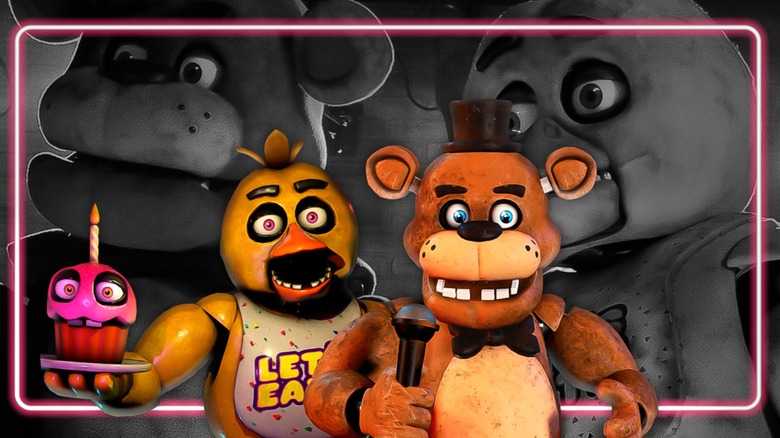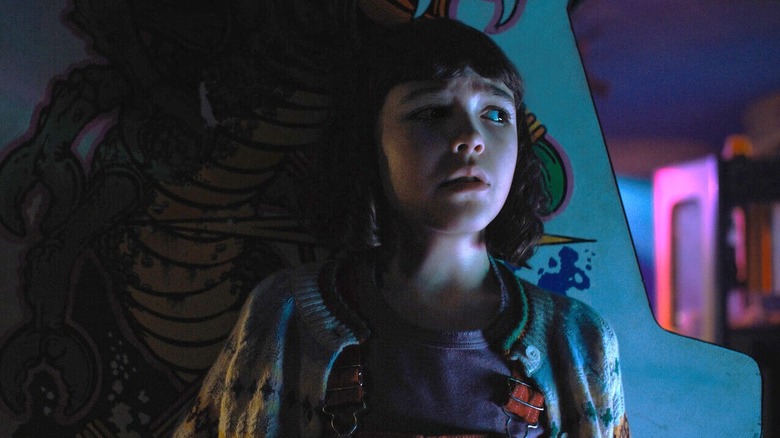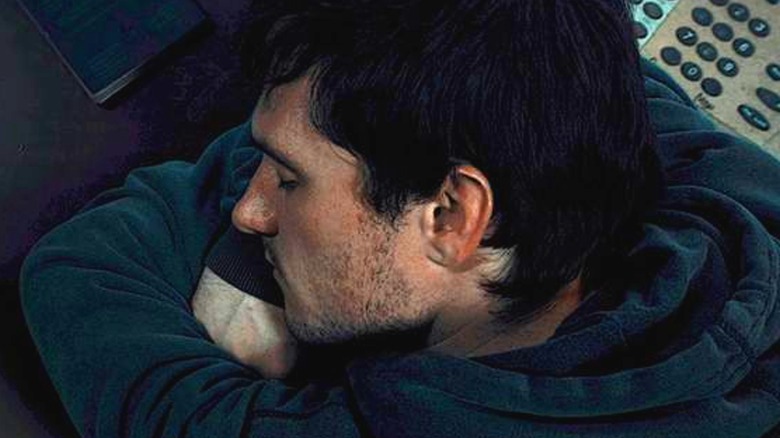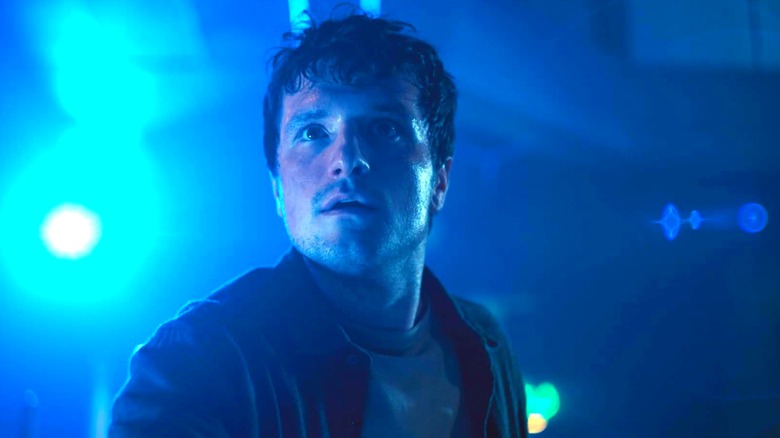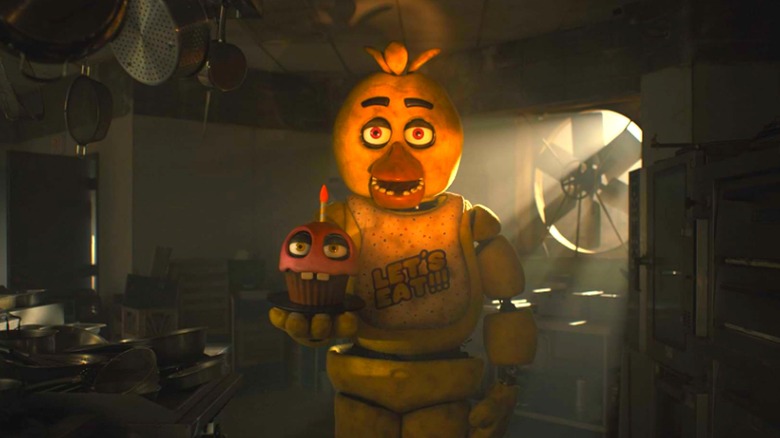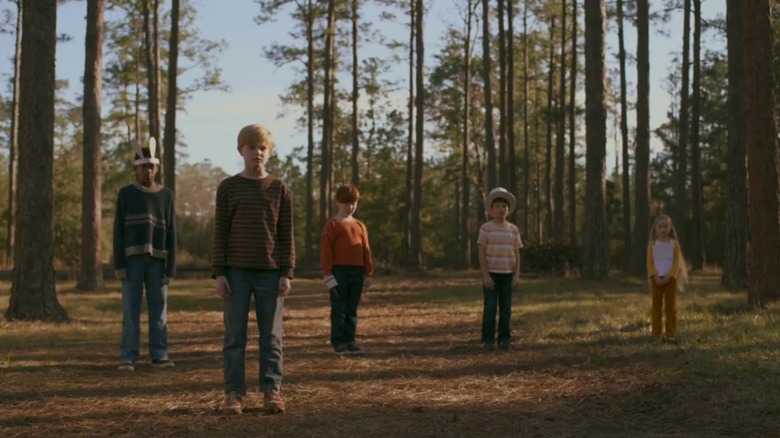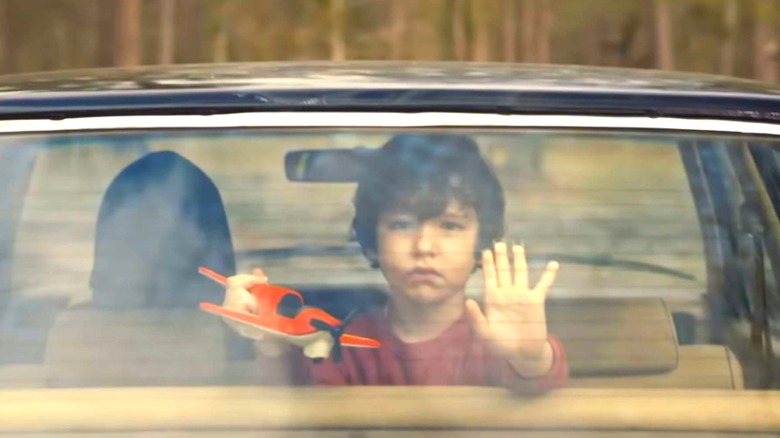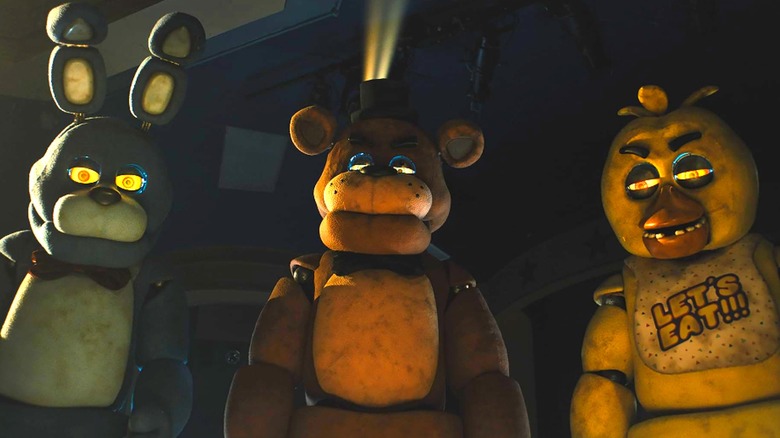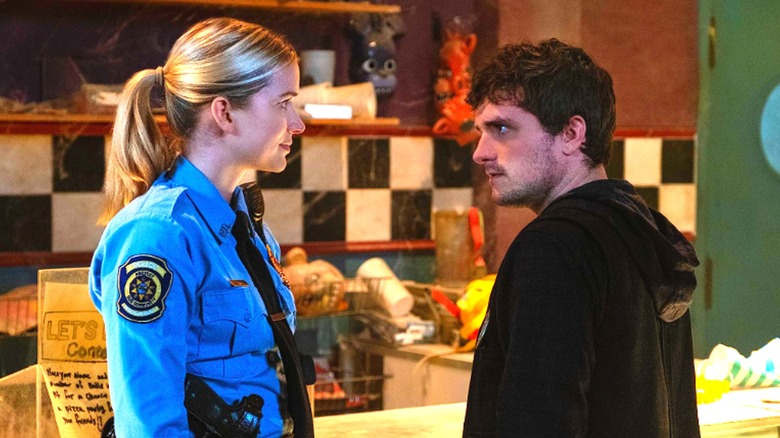Everything The Five Nights At Freddy's Movie Changed From The Games
For anyone who grew up in the era of ShowBiz Pizza and Chuck E. Cheese's, the idea of a kids' pizza place run amok by errant animatronics might seem uncannily familiar. With its simple gameplay and jump scares, the horror game "Five Nights at Freddy's" might not look like much at first glance. However, it's become the obsession of countless tweens everywhere and many a gaming fan thanks to its kid-friendly horror style, colorful storytelling, and increasingly complex lore and worldbuilding.
What seems at first like a silly compilation of jump scares and Easter eggs has become nothing short of a phenomenon, spurring countless fan theories and amassing a cult following. Since the first game's release in 2014, the franchise has expanded with its own canon novel trilogy and a wealth of official merchandise. "FNAF" has also inspired countless works of fan art including fan-made games and songs.
With all that commercial appeal, it was only a matter of time before the franchise finally gave fans the movie they'd been begging for. Now that it's here, we're breaking down the biggest differences between the "Five Nights at Freddy's" film and game series. Hang onto your eye patch because there be spoilers ahead.
The security guard has a more complex back story
The most significant change that the film adaptation made from the "Five Nights at Freddy's" game was the specific back story of the security guard. In the first game, the player takes on the role of the guard. The games are told in first person, and the guard's personality is basically nonexistent. The character is first introduced through a newspaper advertisement seeking a "security guard to work the night shift." In the sequel games, a more specific and detailed biography is given revealing his real name is Michael Afton — one of villain William Afton's children. Further details, including Michael's motivations, are revealed little by little across the game series.
At the end of the first game, we learn the guard's name is Mike Schmidt when the player receives a check from Fazbear Entertainment for $120. While the security guard's name in the "Five Nights at Freddy's" film is also Mike Schmidt (Josh Hutcherson), overall, he seems — at least for now — to have a completely different backstory from his game counterpart. Like Michael Afton, Mike Schmidt's actions in the present (the year 2000, according to security footage) are motivated by his childhood trauma. But Mike Schmidt doesn't recognize William Afton in the film and instead spends a good deal of time thinking about his parents, who are apparently not the Aftons. Just like Michael Afton, Mike Schmidt in the film has two siblings and lost one as a child. But that's where the similarities end.
There's no Phone Guy
Shortly after appearing in the security office of Freddy Fazbear's Pizza, the player of "Five Nights at Freddy's" listens to a recorded phone message from an unnamed character known simply as "Phone Guy," voiced by "FNAF" franchise creator Scott Cawthon. Although Phone Guy introduces himself as someone who used to work in that office and that he is recording from there, it soon becomes apparent that he performs a narrative in-game function of sharing information and tips with the player. During the first game, players receive a call from Phone Guy every night, with each seemingly cheerful message dropping unsettling little tidbits like the fact that the animatronics get a bit quirky sometimes.
Although he does seem to end up dead on Night 4 of the first "FNAF" game, Phone Guy later pops up in other games like "Five Nights at Freddy's 2" and "Five Nights at Freddy's VR: Help Wanted." In the movie, this enigmatic figure is replaced by career counselor Steve Raglan (Matthew Lillard), who is later revealed to be William Afton in disguise. Raglan/Afton takes on the role of feeding Mike Schmidt his instructions and even drops, "I will catch you on the flip side" — a variant on Phone Guy's classic line "See you on the flip side" — at the end of his Night 3 recording. The film also opens with footage of a guard desperately trying to escape, with theorists like ScreenCrush speculating that he could be the Phone Guy from the games.
The game doesn't let you sleep on the job
A key piece of the "Five Nights at Freddy's" film is Mike Schmidt's obsession with lucid dreaming and the way he tries to use this to unlock repressed details about his brother's kidnapping. To help the process along, he habitually drugs himself with sleep meds while listening to some pretty unsettling nature sounds. This obsession goes so completely off the rails that he's even popping pills at a potentially dangerous workplace with his little sister (Piper Rubio) asleep in the next room. It's a bad idea under any circumstances, but in the "FNAF" games, that kind of recklessness would certainly get someone killed. In the "Five Nights at Freddy's" games, the last thing the guard would want to do is accidentally fall asleep on the job — much less do it intentionally.
The security room at Freddy's features two doors on opposite sides. Just outside of those doors are the security system's two biggest blind spots, which means an animatronic can easily disappear from the system only to appear seconds later in a jump scare that means the player's demise is imminent. As Phone Guy makes clear, closing the doors to the office requires precious power that could easily end up drained, leaving the guard unprotected. Once you've run out of power for the night, the doors remain open, which means it's only a matter of time before Sleeping Beauty becomes bunny kibble.
The game doesn't let you fight back
In the first "Five Nights at Freddy's" game, the guard's abilities are pretty much limited to the duties outlined in the "Help Wanted" ad. Players are able to skip through the security cameras, looking over the mostly dark rooms of Freddy Fazbear's Pizza. Monitors are labeled as E. Hall Corner, Dining Area, Show Stage, Restrooms, Kitchen, West Hall, East Hall, Supply Closet, and W. Hall Corner. Aside from checking the monitors, players can flip two switches labeled "Door" and "Light" to temporarily close the doors or turn on the door lights.
But Phone Guy warns the player to "close the doors only if absolutely necessary" because power is limited. Using these limited options, players effectively have to bide their time until dawn, and then rinse and repeat until they've (hopefully) managed to survive the week. While players' possible actions are different in later games like "Pizzeria Simulator" — where players act as franchise owners — the security guard's role is generally defensive.
For obvious reasons, Mike Schmidt can do much more than just push buttons in the "Five Nights at Freddy's" film. Like in the "Sister Location" game, the action in the movie isn't limited to one location in the building, and Schmidt gets into some pretty serious close combat with his animatronic foes. To save Abby, he sneaks into the restaurant and manages to take out Freddy, Bonnie, and Chica with a taser. If only he'd had one in the "Five Nights at Freddy's" game.
The animatronics can also do a little more in the film
It's always been part of the canon that Freddy's animatronics have advanced abilities and even intelligence. However, the movie shows them doing a few things they don't do in the games. The fact that the animatronics tend to exhibit some strange behaviors is disclosed almost immediately in the first "Five Nights at Freddy's" game when Phone Guy explains they are allowed to "roam freely" at night. But, he warns, there's a good chance they'll mistake him for an animatronic endoskeleton and might try to put him back into a costume since naked endos are against the rules. It's something Phone Guy warns "could cause a bit of discomfort and ... death." Worse, he reveals they become more active as the week progresses.
As the player/guard surveys the monitors, the animatronics can be seen in different locations, implying movement. They're also heard making strange and eerie sounds and banging on the door in Phone Guy's Night 4 recording. We also know they're capable of singing, dancing, and stuffing humans inside of suits. And by "FNAF 2," they've been equipped with some sort of advanced facial recognition software and the ability to identify predators.
Still, the movie shows them doing a few — generally more wholesome — things we haven't seen before that imply they're packing some serious A.I. capabilities. Before they turn on Abby, they help Mike, Vanessa (Elizabeth Lail), and Abby build a pillow fort. They're also seen tickling Abby, and one even travels to the Schmidt house to Uber her back to the pizzeria.
They show the children's human forms
Immediately after Mike begins working at Freddy Fazbear's, his dreams that were once populated only by his family and his brother's kidnapper are suddenly filled with images of five strange, eerie children. Throughout the movie, they continue to haunt his dreams, showing up in the woods where Garrett disappeared. He first sees them silently looking on as the kidnapper pulls away with his brother in the car.
When Mike demands they tell him who took Garrett, he sees a flash of one with bleeding black eyes. At first, he doesn't understand who they are or why they're suddenly appearing in his recurring dream but he eventually works out that they're the five children who originally went missing in the 1980s. He also realizes it is their spirits that are inhabiting the animatronics. Each child is somewhat color-coded and dressed to match his or her respective character like the little boy dressed in Bonnie blue wearing a handmade paper bunny ear headband and the redheaded boy with a fake hook on his right hand like Foxy. There's also a blonde boy embodying Golden Freddy, a kid in a top hat who is regular Freddy, and a little girl wearing a yellow cardigan representing Chica.
The ghosts of the five kidnapped children do appear in some of the later games, but never in so much detail. While their spirits are shown in the minigames of "Five Nights at Freddy's 3," their human forms are never actually shown in the games.
The crying child is named Garrett
Another major difference between the games and the "Five Nights at Freddy's" film is the reimagining of the Crying Child. In the game canon, the Crying Child first appears as the protagonist of the minigames in "Five Nights at Freddy's 4." Through the course of the minigames, the narrative tells the tragic story of one of William Afton's two younger children, the unnamed sibling of Elizabeth and Michael. The minigames show how the Crying Child was bullied by his older brother, who, along with three other children, stuffed the child into the mouth of Fredbear as a gag, unaware of the spring-lock system.
Horrifically, the spring-lock system fails, causing Fredbear's mouth to chomp down, biting off the child's frontal lobe and eventually killing him — an event known to fans as the Bite of '83. The traumatic event would set off William Afton's monstrous deeds and lead to Michael Afton's remorseful investigations beginning with the first "Five Nights at Freddy's" game.
In the film, the Crying Child is replaced by Garrett (Lucas Grant), Mike Schmidt's little brother. Mirroring the games' events but altering them, the film also finds Mike Schmidt acting out of remorse. But instead of regret for bullying his brother and getting him killed, Mike Schmidt's guilt is for failing to stop the kidnapper when he was supposed to be watching his sibling. Unlike his mean-spirited game counterpart, the Mike we see in the movie loved his little brother dearly and considered his family near perfect before the crime.
There's no mention of Henry Emily
One major difference between the games and the movie is the notable absence of a key character: animatronic engineer Henry Emily, known in the games as "Cassette Man." Although he doesn't appear in the "Five Nights at Freddy's" movie, Henry Emily plays a pretty significant role in the overarching lore of "FNAF" in the games, so it's possible he could show up in any subsequent sequels. That's not to say Henry is heavily mentioned in the games. But the implications of his story and his connection to the Scott Cawthon-co-authored official book series make him a crucial piece of FNAF lore.
In the games, Henry appears as the cassette guide in "Freddy Fazbear's Pizzeria Simulator." Although the first few recordings are fairly straightforward directions about how to test, maintain, and salvage animatronics, Henry's later recordings get very strange and revealing, addressing the listeners as "Elizabeth," a brave volunteer trapped in a "labyrinth with no exit, a maze with no prize." He also addresses an "old friend" for whom the "darkest pit of Hell has opened." In the Insanity ending, he suggests he was one of the animatronics' creators but that William Afton "set some kind of trap" for the souls that inhabit them. All of this implies that Emily was heavily involved with Afton and the franchise. With Henry's connection to William Afton in the game canon, it's hard to imagine he won't make an appearance in the "FNAF" sequel films.
Vanessa is completely different
Fans of Vanessa from the games may be surprised to see that the film version bears little resemblance to her original iteration. In the film, Vanessa appears as a police officer who shows up to check on Mike when he first starts working at Freddy Fazbear's. It's pretty clear she has an unusual attachment to the location and way more time on her hands than any cop should have, as she ends up lurking around the restaurant long enough to strike up a weird friendship with Mike and eventually Abby.
In the games, Vanessa originally appeared in "Five Nights at Freddy's: Help Wanted" as a computer programmer. While she is testing the "Help Wanted" game the Freddy franchise is releasing to help rehab their image, she uncovers Glitchtrap, another version of William that arises as a glitch trapped in the code that's trying to get out. After the game brainwashes her, she returns in "Security Breach" as both a security guard named Vanessa and a Glitchtrap-controlled bunny suit-wearing villain named Vanny. Aside from their blonde hair, the only resemblance between the film and game version of Vanessa is the revelation that they're both being controlled by someone.
William Afton wasn't Vanessa's dad
The two major reveals in the "FNAF" film are that Steve Raglan is William Afton — who appears in his Springtrap suit toward the climax — and that William Afton is Vanessa's dad. Even more shocking, the photo Vanessa shares of herself as a child next to her father shows her holding onto the orange toy plane Garrett was holding when he was kidnapped by Afton. This family connection seems to be a complete departure from the game lore — at least, according to most fans.
As in the "FNAF" movie, the games depict William Afton as the creator of the Fredbear franchise, hand-sewing the first mascot costumes himself ("FNAF 4," "Security Breach"). By the time he rolls out Freddy Fazbear's Pizza in 1983 — the fateful year that would see his son die — Afton is married with three kids ("FNAF 4"). While we never learn the name of the Crying Child, we know he was a boy. Since the surviving kids were named Elizabeth and Michael, there doesn't seem to be a Vanessa on Team Afton. Still, it's worth noting that there's a fan theory speculating Vanessa is indeed an Afton. According to Redditor u/_LunaDragon_, the theory stems from Vanessa's last name initial "A" and the fact that some fans think they bear a resemblance in the game.
